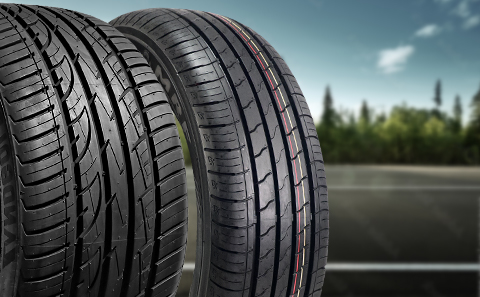Tires have a number of specifications, among which the width is the most significant aspect that can greatly affect performance, responsiveness, fuel efficiency, and ride quality. The thin vs. wide tires discussion is still going on among car lovers, drivers, and professionals in the automobile industry. Each type has its strengths and weaknesses where the handling of the vehicle is based on weather, road condition or other factors. In this article we will discuss the main advantages and disadvantages of thin and wide tires, their features, and which one is better suited to your vehicle.
About Tire Specifications
Before looking at the details of thin vs. wide tires, let’s briefly discuss how tires are measured. Tire dimensions are normally given in the ‘size’, usually shown as P185/70R14. Here’s what each component means:
- P: At the start of the code, it shows it is a passenger car tire.
- 185: This number refers to the width of the tire in millimeters, known as section width or cross section width of the tire.
- 70: Aspect ratio, that is the height of the tire’s sidewall in comparison to the width of it
- R: Abbreviation of “Radial” which is tire construction type.
- 14: The diameter of the wheel (in inches) on which the tire can be used.
Tires are categorized as thin if they have a width of less than 195mm, and wide if they are more than 195mm wide.
Thin Tires
Advantages of Thin Tires
Better Handling in Snow and Rain:
Thin tires have less contact area to the road, so they can easily disperse water from the tread, which helps to reduce the risk of hydroplaning. This feature also increases grip on wet and snowy roads, thus thinner tires are suitable for use in rain or light snow.
Improved Fuel Efficiency:
It is considered that thin tires provide relatively lower rolling resistance than the wider ones. This means that they need less energy to keep moving, which in turn increases fuel efficiency. This characteristic makes the thin tires suitable for the budget-conscious people.
Cost-Effectiveness:
Generally, thin tires are cheaper than wide tires, so they are a preferable choice for the people who want budget-friendly options.
Lightweight Construction:
Thin tires are usually lighter than wide tires and it results in a lighter vehicle. This can help towards improved control and grip, making them more easy to handle.
Disadvantages of Thin Tires
Limited Performance Capabilities:
Thin tires can lack in high speed or performance-based driving conditions. Thin tires typically should not be used in sport cars or vehicles that are mostly used in racing or rash driving.
Reduced Grip on Dry Roads:
As thin tires perform fairly in wet conditions, they can not provide as much grip as wider tires in dry conditions. This can lead to increased braking distances and less cornering stability, poor high-speed stability, and instability during aggressive driving.
Less Comfort:
Thinner tires have stiff sidewalls so they can be less comfortable. It means the people sitting in the vehicle can feel shocks from irregular roads, which in turn give a less comfortable ride.
Wide Tires
Advantages of Wide Tires
Stability at High Speeds:
Wide tires have higher stability when used at higher speeds. They decrease chances of tire squirm, which makes it more useful in performance driving and highway use.
Aesthetics:
Big tires usually improve the looks of a car, providing a more powerful look. The aesthetic advantage is especially desirable to the people who are interested in cars and car accessories.
Enhanced Grip and Handling:
Wide tires provide a greater contact area that offers better performance during acceleration, braking, and cornering. People have better road feel and handling, especially if they own a performance or sport-luxury car.
Improved Load Capacity:
Because of this feature, wide tires generally have the capacity to carry larger loads than thinner tires, which is beneficial for the vehicles that usually haul lots of loads or tow trailers. This feature can also provide additional safety and performance while carrying heavy loads.
Disadvantages of Wide Tires
Increased Rolling Resistance:
Wide tires provide enhanced contact patch or traction while, at the same time, they are associated with more rolling resistance. This can reduce fuel efficiency, especially in urban driving.
Reduced Comfort:
The wider tires have rigid sidewalls so they can absorb less shocks from road irregularities, causing a rougher ride. This can cause increased sound and vibrations coming through the tires.
Higher Cost:
Wide tires cost more than thin ones, not just when buying new ones, but when it is time to replace them as well. Also, they may require wider rims, which will add on the overall cost, depending on the wheel’s size.
Hydroplaning Risk:
In wet conditions, wider tires may be more prone to hydroplaning because a larger area of the tire is in contact with the water. This can cut down the amount of grip and ability to steer around while driving on wet roads.
Performance Comparison
Let’s compare performance attributes of thin tires vs. wide tires.
Fuel Efficiency
All-Season Versatility
Handling
Comfort
Final Words
Each tire has its own advantages and disadvantages that can influence a vehicle's performance. But it is important to note that the suitable tire that should be used depends on the conditions, the type of car being used, and individual preferences about tires. If you learn the thin and wide tires’ features and find out the differences in the performance, you can make the right decision that would improve the driving experience, safety level, and satisfaction.
